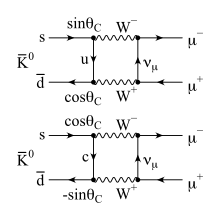GIM mechanism
In quantum field theory, the GIM mechanism (or Glashow–Iliopoulos–Maiani mechanism) is the mechanism through which flavour-changing neutral currents (FCNCs) are suppressed in loop diagrams. It also explains why weak interactions that change strangeness by 2 (ΔS = 2 transitions) are suppressed, while those that change strangeness by 1 (ΔS = 1 transitions) are allowed, but only in charged current interactions.

History
The mechanism was put forth by Sheldon Lee Glashow, John Iliopoulos and Luciano Maiani in their famous paper "Weak Interactions with Lepton–Hadron Symmetry" published in Physical Review D in 1970.[1]
At the time the GIM mechanism was proposed, only three quarks (up, down, and strange) were thought to exist. Glashow and James Bjorken predicted a fourth quark in 1964,[2] but there was little evidence for its existence. The GIM mechanism however, required the existence of a fourth quark, and the prediction of the charm quark is usually credited to Glashow, Iliopoulos, and Maiani.
Description
The mechanism relies on the unitarity of the charged weak current flavor mixing matrix, which enters in the two vertices of a one-loop box diagram involving W boson exchanges. Even though Z0 boson exchanges are flavor-neutral (i.e. prohibit FCNC), the box diagram induces FCNC, but at a very small level. The smallness is set by the mass-squared difference of the different virtual quarks exchanged in the box diagram, originally the u-c quarks, on the scale of the W mass.
The smallness of this quantity accounts for the suppressed induced FCNC, dictating a rare decay, , illustrated. If that mass difference were ignorable, the minus sign between the two interfering box diagrams (itself a consequence of unitarity of the Cabibbo matrix) would lead to a complete cancellation, and thus a null effect.
References
- S.L. Glashow; J. Iliopoulos; L. Maiani (1970). "Weak Interactions with Lepton–Hadron Symmetry". Physical Review D. 2 (7): 1285. Bibcode:1970PhRvD...2.1285G. doi:10.1103/PhysRevD.2.1285.
- B.J. Bjorken; S.L. Glashow (1964). "Elementary particles and SU(4)". Physics Letters. 11 (3): 255–257. Bibcode:1964PhL....11..255B. doi:10.1016/0031-9163(64)90433-0.
Further reading
- A. Das; T. Ferbel (2003). "Standard Model and Confrontation with Data". Introduction to Nuclear and Particle Physics (2nd ed.). World Scientific. pp. 345ff. ISBN 981-238-744-7.
- J. Iliopoulos (2010). "Glashow–Iliopoulos–Maiani mechanism". Scholarpedia. 5 (5): 7125. Bibcode:2010SchpJ...5.7125I. doi:10.4249/scholarpedia.7125.
- Popescu, B. (February 2006). "Weak interactions (1)" (class notes). Physics 842. University of Cincinnati. pp. 45–48. Archived from the original on 11 March 2012. Retrieved 4 September 2010.